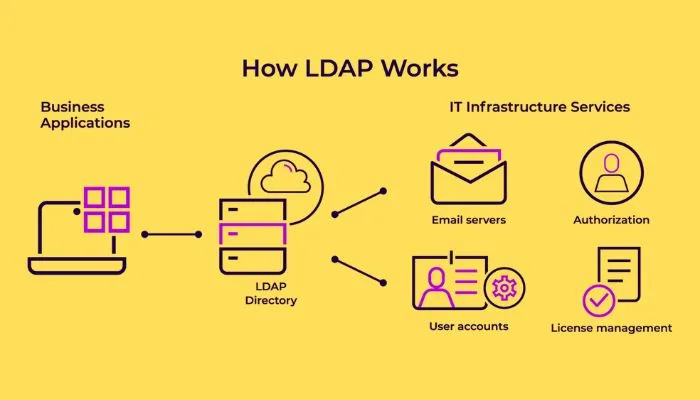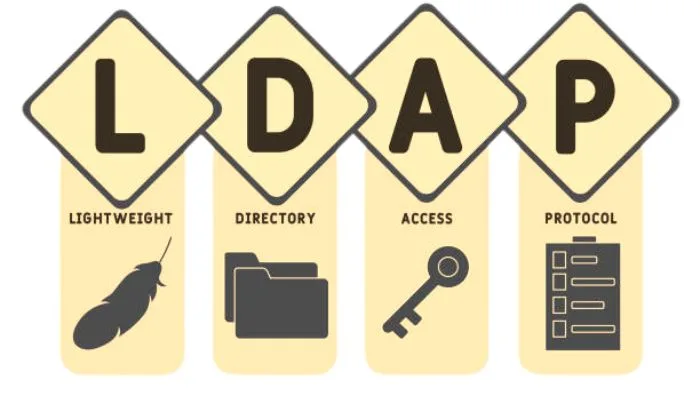In the world of networking, LDAP (Lightweight Directory Access Protocol) plays a crucial role. It is a widely used protocol for accessing and managing information directories. In this article, we will dive into what LDAP is, how it works, the different types of LDAP, and its benefits, and compare it to other protocols.
Table of Contents
What is LDAP (Lightweight Directory Access Protocol)?
LDAP is a lightweight protocol that provides a standardized way to access and manage directory information. It was first introduced in 1993 and has since become the de facto protocol for directory services. LDAP is based on a client-server model, where the client sends requests to the server, and the server responds with the requested information.
An LDAP server is a specialized software application that serves as a central repository for storing and organizing directory information.
Learn More What is LDAP Server? | LDAP Protocol
How does LDAP work?
LDAP works by establishing a connection between the client and the server over a network. The client sends requests in the form of LDAP operations, such as searching for specific information or adding new entries to the directory. The server processes these requests and returns the requested information or performs the specified operation.

LDAP operates on top of TCP/IP, which means it can be used over the internet or within an internal network. It uses a hierarchical structure to organize directory information, similar to the way a file system organizes files and folders. The directory is composed of entries, each representing an object, such as a user or a group. Each entry consists of attributes, which hold the actual information.
Types of LDAP
There are two main types of LDAP: LDAPv2 and LDAPv3. LDAPv2 is the older version and provides basic directory services. LDAPv3, on the other hand, introduced significant improvements and enhancements over LDAPv2. It provides better security, supports internationalization, and includes advanced features like referral chasing and LDAP extensions.
Use Cases of LDAP
LDAP is widely used in various industries and scenarios. Some common use cases include:
- Authentication and Authorization: LDAP is often used for user authentication and authorization in organizations, allowing users to access resources based on their roles and privileges.
- Address Books: LDAP can be used to store and retrieve contact information, enabling users to access a centralized address book across multiple devices and applications.
- Single Sign-On: LDAP can be integrated with single sign-on systems, providing users with a seamless authentication experience across multiple applications.
What is LDAP authentication?
LDAP authentication, which stands for Lightweight Directory Access Protocol authentication, is a method used to verify the identity of a user or system trying to access a computer system or network. It is commonly employed in various IT environments, such as corporate networks, web applications, and email systems, to validate user credentials like usernames and passwords.
Here’s how LDAP authentication typically works:
- LDAP Server: An LDAP server is used as a centralized directory service. It stores user account information, including usernames and their associated passwords, in a hierarchical directory structure.
- Client Request: When a user or system wants to authenticate, it sends a request to the LDAP server. This request typically includes the user’s username and password.
- LDAP Server Verification: The LDAP server receives the request and looks up the user’s account information based on the provided username. It then compares the provided password with the stored password for that user.
- Authentication Decision: If the provided password matches the stored password, the LDAP server confirms the user’s identity, and authentication is successful. Otherwise, it rejects the authentication attempt.
Advantages and Disadvantages of LDAP
Advantages
- Centralized Management: LDAP allows organizations to centralize the management of directory information. This makes it easier to maintain and update information for users, groups, and other objects.
- Scalability: LDAP is designed to handle large-scale directory deployments. It can efficiently manage millions of entries and provide fast access to the information.
- Interoperability: LDAP is a widely adopted standard, which means it can be used with various directory servers and clients. This allows different systems to communicate and share directory information seamlessly.
Disadvantages
Despite its many advantages, LDAP also has some disadvantages:
- Complexity: Setting up and configuring an LDAP server can be complex, especially for beginners.
- Performance: LDAP operations can be resource-intensive, affecting the performance of the server.
- Security: While LDAPv3 offers improved security mechanisms, it still requires proper configuration to ensure the confidentiality and integrity of directory data.
What is LDAP in Active Directory(AD)?
One of the main ways to reach and manage directory services in Active Directory (AD) is through LDAP (Lightweight Directory reach Protocol). Active Directory is a service that Microsoft made to store information about users, groups, computers, and other tools on a network. It is mostly used in Windows-based environments. Active Directory couldn’t work without LDAP.
LDAP is used in Active Directory in the following ways:
- Directory Structure: Active Directory uses a hierarchical directory structure set up as a domain tree, with domains having Organizational Units (OUs) that further organize objects like users, groups, and computers.
- LDAP Queries: The Active information information service can be queried and searched using LDAP. LDAP queries can be used by administrators and applications to find out about users, groups, and other items or to change directory data.
- Authentication: Active Directory also uses LDAP for “authentication.” An LDAP bind action is used to check a user’s credentials when they log to a Windows domain. The user’s login information is sent to the Active Directory server. The Active Directory server uses LDAP to see if the user’s login information matches what it has on file.
- Access Control: LDAP is a very important part of Active Directory’s access control and rights. Using the LDAP directory structure, it lets administrators set entry rights and permissions for users and groups.
- Replication: Active Directory uses a multi-master replication scheme, and LDAP is used to copy directory data between domain controllers. This makes sure that the information in the list is the same and accessible across the network.
- Group Policy: LDAP is also used to handle Group Policy Objects (GPOs) in Active Directory, which set up different settings and configurations for users and computers.
Active Directory’s LDAP is a key part of how a Windows-based network works and how it is managed. It gives a standard way to access directory information and interact with it. This makes it easy to handle users, devices, and resources while keeping them safe and allowing them to grow.
LDAP vs. Other Protocols
LDAP is often compared to other protocols, such as DNS (Domain Name System) and NIS (Network Information Service). While all these protocols serve similar purposes, there are some differences:
- DNS: DNS is primarily used for translating domain names into IP addresses. It focuses on name resolution and does not provide extensive directory services like LDAP.
- NIS: NIS, also known as Yellow Pages, is a directory service used in UNIX-based systems. It is simpler than LDAP and lacks some of the advanced features provided by LDAPv3.
In conclusion, LDAP is a powerful protocol that provides a standardized way to access and manage directory information. Its hierarchical structure, scalability, and interoperability make it an ideal choice for organizations of all sizes. By understanding LDAP and its benefits, you can better leverage its capabilities to meet your networking needs.



